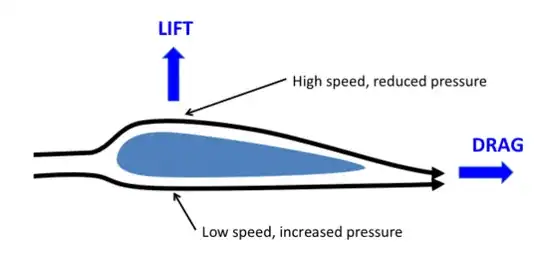You would be well advised to leave the buoyancy force out of it. It is negligible for an airplane since the density of air is low.
An aerofoil (e.g. aircraft wing) is pushed upwards by the difference in pressure between the bottom and the top surfaces. The wing is shaped and then angled during flight in such a way that the air pressure on the top surface of the wing is lower than the pressure on the bottom surface. The higher pressure at the bottom results in a net force is upwards. Airspeeds are higher
There is an image of the observed reality below, from https://www.skybrary.aero/index.php/AP4ATCO_-_Aerofoil_Terminology
The pressure-speed causality explanation gets a bit involved, as attempted in a Cambridge University article here. The figure does capture the experimentally observed reality (airspeeds and pressure at the top and bottom surfaces).
The shape of the trailing edge of the aerofoil is also a factor in generating lift. From the reference quoted in the figure:
"Leading edge slats, leading edge Krueger Flaps and trailing edge (Fowler) flaps, when extended from the basic wing structure, literally change the aerofoil shape into the classic concave form, thereby generating much greater lift during slow flight conditions.".
Increasing the angle of attack, which is, tilting the aerofoil so that the leading edge is higher than the trailing edge, does increase lift, for the mere fact that the there is a resultant upward force on the aerofoil as the wind pushes on the underside. The downside of this is that it generates significant drag as a side effect, so it is generally not desirable for cruising. Beyond a critical angle (often found to be around $15^o$), the lift effect collapses, known as stalling.
There is a popular 'longer path' explanation for the lower pressure over the top of the aerofoil, but this is considered incorrect by sources at NASA and the Cambridge University article mentioned above.

Further description after a question by @coderhk.
For a fluid, Bernoulli's equation states that:
$P_1 + \rho v^2 + \rho gh = constant$,
i.e. the sum of pressure energy, kinetic energy, and potential energy is constant. In this equation, $\rho gh$ is the potential energy(per unit volume) of the fluid at a particular point as it moves around the aerofoil, and not the average buoyancy pressure experienced by the aerofoil. The other two terms (pressure and kinetic energy) are also not averages, but point properties as the fluid moves around the aerofoil. To calculate the buoyancy force due to this complex fluid (air in motion), you would need to do something like "calculate the average potential energy pressure ($\rho gh$) around the wing", and multiply that by the volume of the wing.
